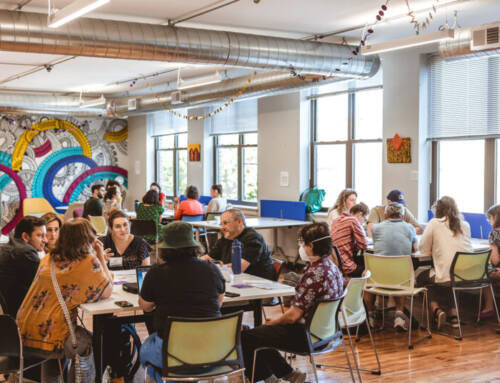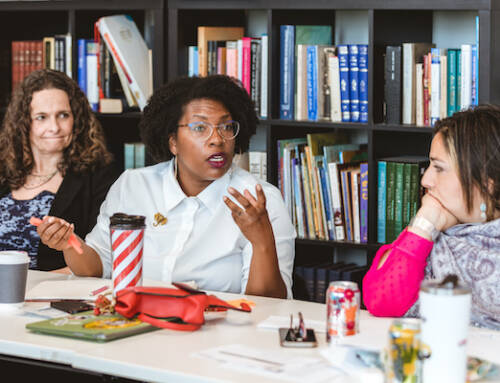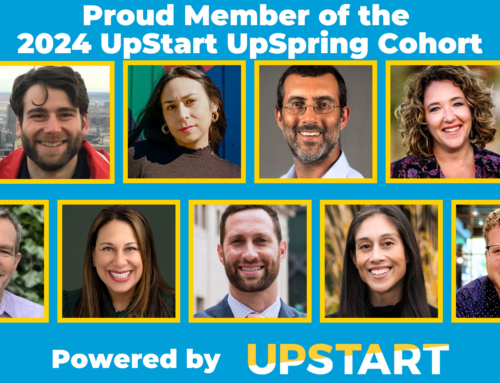Perhaps this year the Jewish community can commit itself to taking professional development to the next level, identifying what it might threaten if it is taken seriously, and learning to tolerate some discomfort, some awkwardness, for the sake of swifter, smoother, healthier movement.

There is often an aspect of loss involved in any change process.
I was quite gung-ho about swimming lessons when I imagined myself swimming alongside Michael Phelps, grinning as I pulled past him. When I realized that the lessons would mean changing the entire way I moved in the water, and that it was going to take time, patience, and much practice, changing the way I exercised in the water for many months, I became much less excited. I subconsciously attempted to separate my “real” swimming self from my “lessoned” swimming self. Those exercises are great to do in a lesson, I told myself, but they have no place here, when you’re really swimming. When I realized what I was going to lose, even for the sake of some greater gain, it became much harder for me to stay invested in the process.
‘Tis the season for resolutions to do better both individually and organizationally. One such way we do that in the work world is to invest in professional development. Sometimes, we invest in professional development for the same reasons I invested in swim lessons; we are afraid that if we continue down our current path, without growing or changing or learning in some way, we might get hurt in the future, or we might not succeed in the future. Sometimes we invest in professional development simply for the sake of growth and learning, and increased likelihood of impact and success. Sometimes we invest in professional development when we are in crisis, and need help in order to survive.
But no matter the reason, our organizations often react to professional development opportunities the way that I have reacted to my swimming lessons. Unless we are literally drowning, and therefore willing to do anything it takes to learn how to swim through the water, we often resist the very growth that we have invested in. And the reason we resist the new ideas, the new ways of working, is because it threatens something in our current reality, or current perception of ourselves. If we are to take the learning and new ideas seriously, something from our current way of functioning either must be sacrificed, or adapted. Often, that is so threatening that it shuts down our willingness to engage in the new ideas.
I would like to share two examples of initiatives that have identified this trend in professional development, and which are attempting to counter-act this basic human reaction by designing new ways of supporting professional development in the organizational system as a whole:
1. The Jewish Education Project and UpStart Bay Area are in a second year of experimenting with a new model of Professional Development for professionals in Jewish Day Schools. This model was designed based on data from Day School Heads who shared that, while they have had many wonderful professional development opportunities, and felt that those opportunities helped them grow as professionals, those opportunities, overall, did not translated to substantial changes in their schools. In direct reaction to this frustration, UJA Federation of New York generously funded a new model, called the Day School Collaboration Network, which is attempting to create systemic school change by training teams of teachers, administrators, and often parents from schools to learn new ways of working and thinking. The expressed desired outcome is that these individuals, working across sectors in teams, supported by similar teams from other schools, will, virus-like, infiltrate their school-system with these new vocabularies, methodologies, and tools. While these teams are pulled out of school for traditional professional-development seminars throughout the course of the year, the teams are also supported year-round by coaches who work with them as they experiment and test new ideas with students, faculty, and parents in their buildings. This model is built upon the concept that it is more effective to infuse ideas into a system directly than to take people out of a system to teach them. This would be akin to my swimming teacher showing up each time I go for a swim, and giving me some pointers as I’m doing laps, infusing the new way of swimming into my existing routine.
2. Yeshiva University’s Center for the Jewish Future has been running a Certificate Program in Experiential Jewish Education for Jewish professionals for four years now. One of their findings, after the first couple of years, was that the program participants felt varying levels of frustration upon returning to their jobs. They were inspired during their seminars by new conceptual frameworks, yet found themselves unable to utilize these frameworks, or translate these new ideas, back into their workplace. Shuki Taylor, the Program’s Director, realized that if this program is to succeed, YU needed to figure out a way to better help the program participants translate their learning into their day to day jobs, and into their organizations as a whole. As an experimental way of addressing this challenge, he launched, with guidance from and in partnership with Upstart Bay Area, an Inaugural Supervisors’ Symposium this December, bringing together the program participants’ supervisors, in order to expose them both to the types of ideas that their employees study in depth over the course of the year, and to engage them in trying to figure out how to best translate that learning into their institutions. One of the findings of this day was that the supervisors were surprised to learn that their employees were often hesitant to bring these new ideas into their workplace, and that the challenge of implementation needed to be addressed with guidance and support from their supervisors, who could only do this if they knew more about what their employees are learning.
The challenge facing this particular program and many other professional development programs is how to simultaneously acknowledge the supervisors’ genuine efforts to support the program participants, while surfacing the many challenges of applying newly learned practices. Exposing the supervisors to the programs’ curriculum, and discussing with them the challenges that come with creating change, ensures that the supervisors will be committed both to the new ideas and the employees, and to their role in assuring a workplace that encourages risk taking and change.
In some ways, the professional development model of the YU Certificate Program in Experiential Jewish Education is analogous to pulling a whole bunch of swimmers out of the pool for special training, and then putting them back into a pool with team captains whose focus is the team’s speed. Of course, those captains support the swimmers’ getting special lessons they are happy for the swimmers to advance and grow. But they are ultimately responsible for their team’s success. Unless the captains also receive training, and understand that the new way of swimming might slow everyone down for a while, or take away the elegance of the team, or even change the way the whole team functions together, it is unrealistic to assume that they will genuinely allow these few swimmers to return and begin to experiment with thrashing about in the water.
These are two examples of ways in which professional development can occur more effectively. We have the right idea when we make New Year’s resolutions, and when we sign ourselves and our colleagues up for new training, new growth. But we get in our own way. We resist the waves in the water, and we revert to our old patterns.
Perhaps, inspired by these new models, this year the Jewish community can commit itself to taking professional development to the next level, identifying what it might threaten if it is taken seriously, and learning to tolerate some discomfort, some awkwardness, for the sake of swifter, smoother, healthier movement.
This article is cross-posted on eJewish Philanthropy.
Our purpose is to enable entrepreneurs to bring bold Jewish ideas to light. We help them reach Up to people in new ways that are meaningful, more inclusive, and create a brighter future for our Jewish community and the world we share.




